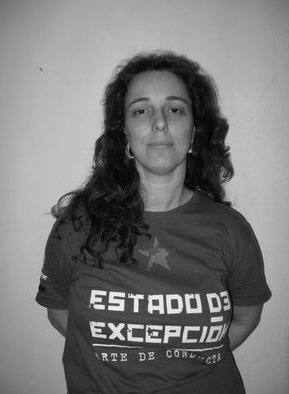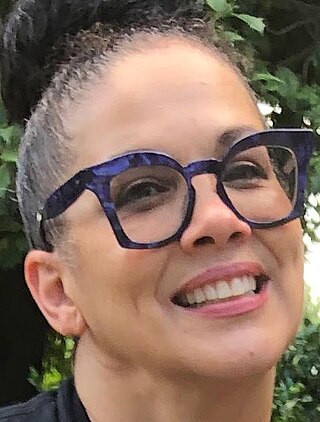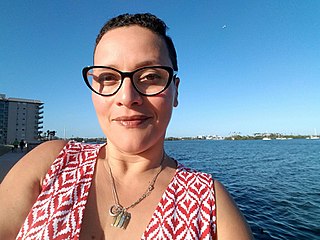
Guillermo Gómez-Peña is a Mexican/Chicano performance artist, writer, activist, and educator. Gómez-Peña has created work in multiple media, including performance art, experimental radio, video, photography and installation art. His fifteen books include essays, experimental poetry, performance scripts, photographs and chronicles in both English, Spanish and Spanglish. He is a founding member of the pioneering art collective Border Arts Workshop/Taller de Arte Fronterizo (1985-1992) and artistic director of the performance art troupe La Pocha Nostra.
Dana Schutz is an American artist who lives and works in Brooklyn, New York. Schutz is known for her gestural, figurative paintings that often take on specific subjects or narrative situations as a point of departure.

Teresita Fernández is a New York-based visual artist best known for her public sculptures and unconventional use of materials. Her work is characterized by an interest in perception and the psychology of looking. Her experiential, large-scale works are often inspired by landscape and natural phenomena as well as diverse historical and cultural references. Her sculptures present spectacular optical illusions and evoke natural phenomena, land formations, and water in its infinite forms.

Tania Bruguera is a Cuban artist and activist who focuses on installation and performance art. She lives in Cambridge, Massachusetts where she works as head of media and performance at Harvard University. Bruguera has participated in numerous international exhibitions. her work is in the permanent collections of many institutions, including the Museum of Modern Art and Bronx Museum of the Arts and the Museo Nacional de Bellas Artes de La Habana.
Dawn Kasper is a New York-based interdisciplinary artist working across genres of performance, installation, sculpture, drawing, photography, video, and sound. Her often improvisational work derives from a "fascination with existentialism, subjects of vulnerability, desire, and the construction of meaning." Kasper uses props, costume, comedy, gesture, repetition, music, and monologue to create what she refers to as "living sculptures."
Juan Sánchez, also Juan Sanchez is an American artist and educator. He is an important Nuyorican cultural figure to emerge in the second half of the 20th century. His works include photography, paintings and mixed media works.
Leandro Soto was a Cuban-American multidisciplinary visual/installation and performance artist. He was also a set and costume designer for theater and film. Soto studied at Escuela Nacional de Arte National Art Schools (Cuba) and Instituto Superior de Arte, University of Havana. As an educator he taught and lectured at various Higher Education institutions in the U.S. and abroad. Soto also founded a creative workshop, El Tesoro de Tamulte, in Tabasco, Mexico, from which professional artists emerged.

Tonita Peña born as Quah Ah but also used the name Tonita Vigil Peña and María Antonia Tonita Peña. Peña was a renowned Pueblo artist, specializing in pen and ink on paper embellished with watercolor. She was a well-known and influential Native American artist and art teacher of the early 1920s and 1930s.

Nao Bustamante is a Chicana interdisciplinary artist, writer, and educator from the San Joaquin Valley in California. Her artistic practice encompasses performance art, sculpture, installation, and video and explores issues of ethnicity, class, gender, performativity, and the body. She is a recipient of the 2023 Rome Prize.
Sarah Michelson is a British choreographer and dancer who lives and works in New York City, New York. Her work is characterized by demanding physicality and repetition, rigorous formal structures, and inventive lighting and sound design. She was one of two choreographers whose work was included in the 2012 Whitney Biennial, the first time dance was presented as part of the bi-annual exhibition. Her work has also been staged at The Walker Art Center, Jacob’s Pillow Dance Festival, The Kitchen, and the White Oak Dance Project. She received New York Dance and Performance awards for Group Experience (2002), Shadowmann Parts One and Two (2003), and Dogs (2008). She has served as associate director of The Center for Movement Research and associate curator of dance at The Kitchen. Currently choreographer in residence at Bard's Fisher Center, she is the recipient of their four-year fellowship to develop a commissioned work with Bard students and professional dancers.
Beatriz Santiago Muñoz is an artist based in San Juan, Puerto Rico. Her work combines aspects of ethnography and theater to create film and video projects that have touched on subjects including anarchist communities, the relationship between artwork and work, and post-military land. Her work has been exhibited at the Tate Modern, the Whitney Biennial 2017, Galería Kurimanzutto, and the Guggenheim Museum. She is co-founder of Beta-Local, an art organization and experimental education program in San Juan, Puerto Rico.

Elia Alba (1962) was born in Brooklyn, New York. She is a multidisciplinary artist who lives and works in Queens, New York. Alba's ongoing project The Supper Club depicts contemporary artists of color in portraits, and presents dinners where a diverse array of artists, curators, historians and collectors address topics related to people of color and to women.

Claire Tancons is a curator, critic, and historian of art. She was born in Guadeloupe and is currently based in Paris, after spending three years in Berlin and eighteen in the US, of which she lived a decade in New Orleans.
The Couple in a Cage: Two Amerindians Visit the West was a 1992–93 performance art piece by artists Coco Fusco and Guillermo Gómez-Peña for their exhibition The Year of the White Bear and Two Undiscovered Amerindians Visit the West which toured five countries and was performed in nine different locations. First performed in honor of the quincentenary anniversary of Christopher Columbus' arrival to the Americas, the work sought to make visible the history of abuse, captivity and exploitation of indigenous peoples. Their inspiration drew heavily upon the history of othering, the human zoo, and life stories of historical figures such as Ota Benga and Sarah Baartman—beginning with the kidnapping of Arawak Indian by Columbus and his men to be displayed in the Spanish Court.
Antonieta Sosa is a Venezuelan performance artist born in New York. Her notable performance works include Conversación con agua tibia and Del Cuerpo al Vacío. Her early work includes abstract art pieces such as Visual Chess (1965), which is in the Museum of Modern Art's online collection.

Kambui Olujimi is a New York-based visual artist working across disciplines using installation, photography, performance, tapestry, works on paper, video, large sculptures and painting. His artwork reflects on public discourse, mythology, historical narrative, social practices, exchange, mediated cultures, resilience and autonomy.
Carlota Eugenia Rosenfeld Villarreal, known as Lotty Rosenfeld, was an interdisciplinary artist based in Santiago, Chile. She was born in Santiago, Chile, and was active during the late 1970s during the time of the Chilean military coup d'état. She carried out public art interventions in urban areas, often manipulating traffic signs in order to challenge viewers to rethink notions of public space and political agency. Her work has been exhibited in several countries throughout Latin America, and Internationally in places such as Europe, Japan, and Australia.

Wanda Raimundi-Ortiz, is an American interdisciplinary artist of Puerto Rican descent born in The Bronx, NY and based in Orlando, FL.
Natalie Ball is a Klamath/Modoc interdisciplinary artist based in Chiloquin, Oregon.
Prema Murthy is an American, multi-disciplinary artist based in New York. Employing aesthetics, gesture, geometry and algorithmic processes, Murthy's work explores the boundaries between embodiment and abstraction, while engaging in issues of culture and politics. Her work has been exhibited nationally and internationally at MoMA PS1, the Whitney Museum of American Art, the New Museum of Contemporary Art, the Reina Sofia Museum, the Generali Foundation in Vienna, and the India Habitat Center-New Delhi.









